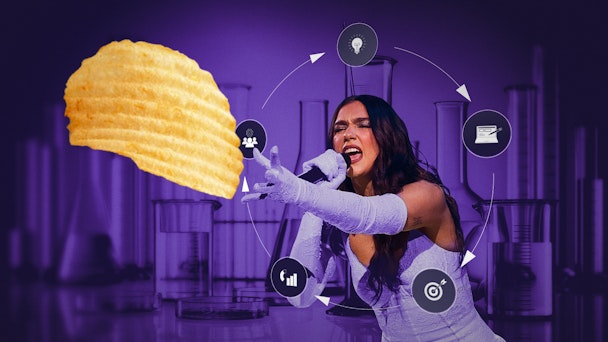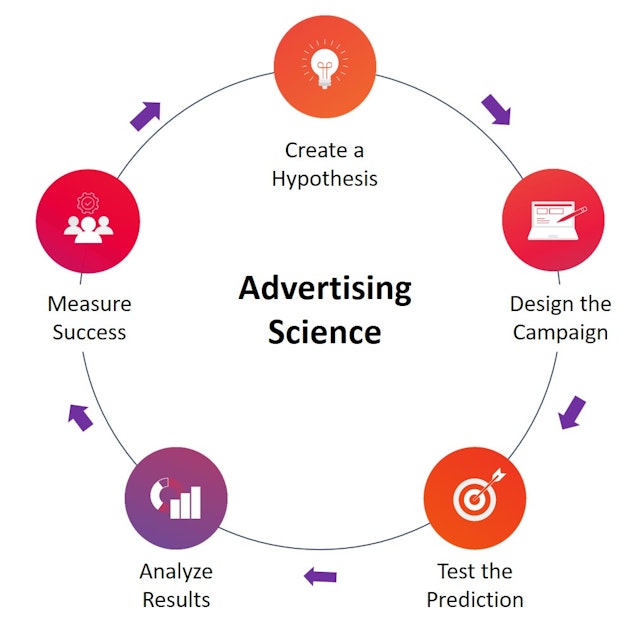Advertising science: Applying the scientific method to create data-driven campaigns
For The Drum’s latest Deep Dive, The New Data & Privacy Playbook, Wes Morton (founder and CEO of Creativ Strategies) lays out a scientific framework to thoughtfully apply data and improve your next campaign.

The scientific method is humanity’s best tool for ascertaining truth. It represents a proven way of testing observations in the real world in order to determine whether our views, perspectives or theories about reality are true.
Overall advertising effectiveness remains marketer’s top challenge. Methodic testing addresses this, increasing creative conversion, refining media spends, and improving overall advertising.
One scientific analysis Creativ Strategies conducted for a gaming client found the conversion rate delta between the worst and best performing creative landing pages was an eye-popping 243%. A 20% versus an 8% conversion rate resulted in a 2.5x lift in conversion efficiency for the same game.
Here, I’ll explain how the empirical study of truth, now commonly referred to as ‘science’, can be applied to advertising.
What is advertising science? Defining the discipline
Advertising science requires three things:
- A hypothesis: An assumption about the consumer
- Data: Agreed upon metrics that can prove the validity of the hypothesis
- An experiment: Your campaign, in which you test the hypothesis against the data
Every marketing campaign should be viewed through the lens of a hypothesis. Your big idea, newsletter, panel, new piece of content, TV spot, strategy, experiential activation, sponsorship, or campaign is not a guarantee; it is an assumption.
Assumptions need not be baseless. Good assumptions are based on observable facts or past experience about your target consumer. Smart marketers collect data beforehand or use prior successful campaigns as reference points to root their assumptions in reality.
However, with any assumption comes the possibility of failure. New, untested assumptions require the realization that your marketing hypothesis could fail. While failure is a possibility, the reward is a deeper understanding of your target consumer.
Applying the scientific method to your advertising
You can break a scientific experiment into five simple steps.

1. Create a hypothesis
In this stage marketers should form their assumptions about their target consumers.
Imagine a potato chip brand aims to reach young Gen Z consumers. A marketer could form an inductive hypothesis by collecting information on Gen Z.
For example, a marketer could form an initial hypothesis knowing that Gen Z spends three hours a day on TikTok, their top genre of music is pop and hip-hop music, and 77% of them snack at least once per day. Therefore, the advertiser hypothesizes an ad featuring Dua Lipa served on TikTok will incrementally increase chip sales. The hypothesis becomes: We think Dua Lipa will sell chips.
2. Design the campaign
Said advertiser decides to run the campaign during the Summer and measure the incremental increase in sales as a result.
Importantly, the advertiser should control for other marketing activities. This means only shifting the primary ad served during the summer while keeping all other marketing activities the same in order to isolate that specific activity.
By controlling for other activity, your campaign will clearly demarcate the hypothetical variable we are testing (Dua Lipa) against the data, incremental sales lift, that tests it. Said plainly, this advertising campaign should tell us: “does Dua Lipa sell chips?”
3. Test the prediction
We run the campaign of the Dua Lipa chip ad over the summer.
4. Analyze the results
At this step, advertisers collect the necessary data that confirms or denies the hypothesis, “We think Dua Lipa sells chips.”
Critically important here is all the data marketers often demand but do not use. Impressions, clicks, engagements, retweets, hashtags, GRPs, do not answer the question “does Dua Lipa sell chips?” They are noise that should be discarded. You do not need to capture all the data. The only relevant data worth collecting should answer the hypothesis your campaign posed.
In our case, the advertiser will collect data on incremental sales lift of chips during the three months in summer when the Dua Lipa ad aired.
5. Measure success
Confirm or deny your hypothesis. Was one kiss all it takes? An incremental sales lift confirms the hypothesis that Dua Lipa in fact does sell chips. A flat sales curve or down sales curve denies the hypothesis, telling the advertiser to do a full 180 and find a new love.
Once success has been measured, one way or the other, the marketing team is empowered to form a new, more informed hypothesis based on the results. Subsequent rounds of applied advertising science sharpen each following campaign.
Five simple steps to verifiable consumer truths. That is the power of advertising science.
Realities of applying the scientific method to advertising
The real world is more complex than the scenario above. Multiple marketing activations will be running at the same time, factors outside the control of marketers affect chip sales, and not everyone can book Dua Lipa.
However, advertising science can improve campaigns by aligning data realities with the decisions marketers make. Each hypothesis, campaign, experiment, will add to your team's understanding of the consumer, creating a tome of knowledge that future marketers can refer to for answers.
Here’s three takeaways to apply the scientific method to your next campaign:
- Design your next campaign around a clear hypothesis. Attempt to isolate or control for factors that could muddy your results. The logic should clearly tell you whether X causes Y.
- You don’t need to measure everything. Only data that confirms or denies your hypothesis should be factored. Discard the noise.
- Be honest. For obvious reasons every campaign is framed as a success. A good marketing team celebrates success. A great marketing team celebrates their failures just as much.
Happy experimenting.
Content by The Drum Network member:

Creativ Strategies
Creativ Strategies is a full-service marketing consultancy and studio for media, entertainment, and tech brands. Challenges welcome.
Find out more
